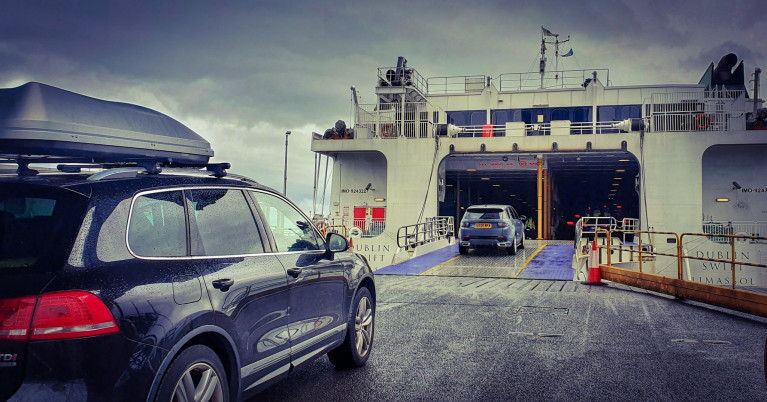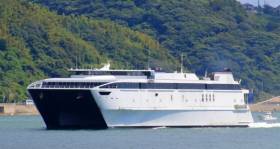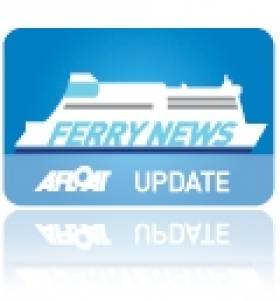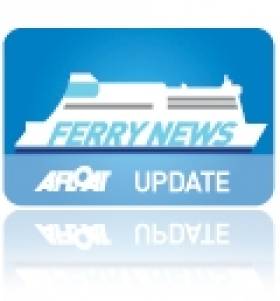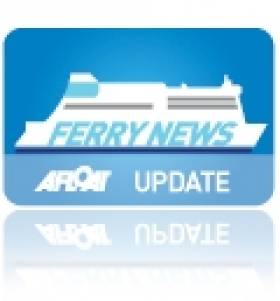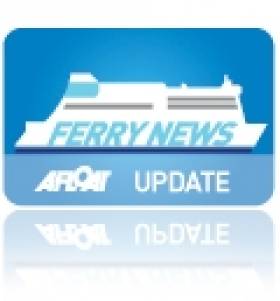Displaying items by tag: Dublin Swift
Dublin Swift Heads for West Country Prior to Wales Route Resumption While Stena Europe Awaits Falmouth for Orders?
Less than a week ago, Afloat tracked Irish Ferries Dublin Swift at Cardiff, however the fast ferry has since sailed from Wales to England, for dry-docking in advance of resuming seasonal service to Holyhead next month, writes Jehan Ashmore.
The Cypriot flagged Dublin Swift went to A&P Falmouth, where Afloat also tracked the recently replaced Rosslare-Fishguard ferry, Stena Europe, following the return of Stena Nordica to service upon completion of works to a berth linkspan at the south Wales port. This finally released the ‘Europe’ to head for Falmouth and receive a dry-docking, which has also taken place with the 1982 built ferry currently remaining in the Cornish port alongside a layover quay.
When Stena Europe made an unexpected return to the Ireland-Wales in January, the ageing ferry had been on charter across the Strait of Gibraltar, linking Spain and Morocco. So after a stint spent on the Europe-Africa route, it was a surprise to see the return of the veteran vessel in its 42 year make its presense to its old homeport of Fishguard after seemingly leaving for the final time in July last year.
It was during a personal ‘farewell’ crossing made last month, that it was observed that the long-serving St. Georges Channel ferry of 21 years, had been re-registered (likewise of Dublin Swift) to Limassol, Cyprus, with the ferry now part of Stena Line Pte Ltd of Singapore, Asia.
For ferry fans and Welsh locals of the Fishguard favourite, the ferry no longer has its homeport of registry, and the ‘Red Duster’ is also absent from the stern flagpole. So what winds will next blow for the ferry and in what direction?
Afloat still awaits a response from Stena as to the future of the ferry which, until last year, had boosted the largest passenger capacity on their Irish Sea network, with an impressive 2,076 passengers in total. However, that accolade ceased on the last day of June with the introduction of the Rosslare-Cherbourg route’s larger of two ferries, Stena Vision, with 2,400 guests.
Now again, the Stena Vision regains this status as one of the largest in the overall Stena Line fleet, which includes those serving in the North Sea, throughout the Nordic nations, and on the Baltic Sea.
Dublin Swift’s Countdown to Dublin-Holyhead High-Speed Craft (HSC) Seasonal Operated Service
Irish Ferries high-speed craft (HSC) Dublin Swift has been tracked by Afloat to Cardiff Docks, south Wales, where the vessel has been wintering, but in a month’s time is to resume seasonal service, writes Jehan Ashmore.
According to the Irish Ferries website, Dublin Swift is to start on 17 May with a Dublin-Holyhead sailing, and this will be in advance of the busier summer months on the Ireland-Wales route, complementing the year-round cruise-ferry-operated route.
Passage times by Dublin Swift are just over 2 hours (135 minutes) on the route on which the HSC represents the only fast ferry operating on the Irish Sea, connecting 'directly' between Ireland and the UK; the only other such craft is the Isle of Man Steam Packet’s Manannan; see yesterday's story.
Dublin Swift takes 900 passengers and drive-through vehicle decks for 200 cars and 16 trailers and provides two sailings daily from each port. On board, there is a club-class lounge, restaurant, cafe, shop, TV lounge, and passengers can avail of free Wi-fi.
The 101-metre Austal Auto-Express craft was built in 2001 by Austal Ship Pty, Fremantle, Western Australia, as the Westpac Express and was chartered through third-party companies to the US Marine Corps as a support vessel until it returned to Austal in 2015.
In the following year, Irish Continental Group (ICG), the parent company of Irish Ferries, acquired the HSC from Austal; however, the craft was chartered to the Sealift Inc. of the USA for use again by US Marine Corps until the charter ended in 2017. This led to the craft laid up in Belfast.
It was not until 2018 when the HSC was renamed Dublin Swift, which made its debut in April of that year for Irish Ferries.
The Cypriot flagged 101.4 metre-long craft and with a beam of 26.65 metres replaced another HSC, the Jonathan Swift, which was sold to interests in the Mediterranean.
Dublin Swift Prepares for Fast Ferry Sailings to Holyhead While Disruption Continues at Dover-Calais
Afloat tracked Irish Ferries high-speed craft (HSC) Dublin Swift to Holyhead on Friday, having departed last month from Belfast Harbour on the repositioning voyage to north Wales, writes Jehan Ashmore.
The HSC which had been at Harland & Wolff for annual dry-docking, completed the Irish Sea passage in four hours, in preparation for this year’s return to seasonal service on the Dublin-Holyhead route
Dublin Swift as previously reported, is set to sail from its namesake port this Friday, 10 March, one week prior to the busy St. Patrick’s Day bank holiday weekend with capacity available for 900 passengers and 200 cars.
The high-speed sailings which also handle 16 lorries, takes just over 2 hours on the Ireland-Wales route. Whereas conventional cruiseferry crossings by Ulysses and by the more freight oriented (ropax) vessel Epsilon take 3 hours 15 minutes.
Dover-Calais disruption
Also on Friday is when an engine-room fire on board Isle of Innisfree took place and was contained with no injury to crew nor passengers having disembarked safely at Calais.
The incident however led to cancelled sailings which currently remains in place on the Irish Ferries UK ‘landbridge’ service on the Dover-Calais route.
Other sailings, however are been maintained, albeit by just one ferry, the Isle of Inishmore, though the 'Innisfree' is set to return to service on Wednesday, 8 March.
This reduction in sailing frequency has also been compounded as a third route ferry, Isle of Inisheer is also off-service due to dry-docking at Harland & Wolff, Belfast.
Afloat also notes that according to the operator's sailing updates, the 'Inisheer' is listed for sailings on Thursday, 9 March, however on that day, the company regrets that all sailings have been cancelled due to technical reasons. Customers will however be accommodated on other sailings.
Sailings take 1 hour 30 minutes on the service which Irish Ferries began in July, 2021.
For the latest sailing updates on the Strait of Dover route, along with Ireland-Wales routes and connecting Ireland-France, they can be consulted here.
In addition to the link above is a 24hr pre-recorded telephone information service.
Irish Ferries High-Speed Craft Returns to Service During Dublin-Holyhead Route's High-Season
Irish Ferries high-speed craft Dublin Swift finally returned to service on the Dublin-Holyhead route with holidaymakers travelling during this summer's key peak-season month, writes Jehan Ashmore.
With the easing of Covid-19 travel restrictions introduced last month, Irish Ferries this week resumed the HSC Dublin Swift service, offering customers an alternative faster option on the Irish Sea's only direct cross-channel fast-ferry service between Ireland and the UK.
Asides the conventional cruiseferry Ulysses and ropax Epsilon, each taking 3 hours 15 minutes to complete, the Dublin Swift's passage time is just 1 hours 49 minutes. This is achieved by the HSC's 35 knot capability when running between the Irish capital and the north Wales port in Anglesey.
Dublin Swift's sailing schedule sees two sailings in each direction daily and with travel restrictions in many countries currently being relaxed, Irish Ferries have introduced additional measures across their fleet to ensure that both passengers and crew can ‘Travel Safe’.
In pre-pandemic times, such fast-ferry operations on the Ireland-Wales link would of begun much earlier, with the season starting in April.
Facilities on Dublin Swift include a Club Class lounge, Brassarie, Cafe, TV lounge, Gaming Zone and Wi-fi connection is available. In addition an on board shop. Noting, that the Irish Ferries website cites that due to the impact of Covid-19, not all advertised ship facilities may be open.
The HSC Dublin Swift, likewise of its predecessor, Jonathan Swift was built by Austal-Ships, Freemantle, Australia in 2001 and can carry 900 passengers, 200 cars and 16 trucks. The twinned hull craft originally entered service for Irish Ferries in 2018 having been acquired as secondhand tonnage.
This year is the first summer season that Irish Ferries can also offer customers an inclusive UK 'land-bridge' service with the opening in June of their new service on the Dover-Calais route. The new UK-France service followed the transfer of cruiseferry Isle of Inishmore from the Rosslare-Pembroke route currently served by the chartered-in Greek flagged ferry Blue Star 1.
In addition, Irish Ferries run direct Ireland-France services on the Dublin-Cherbourg route served by cruiseferry W.B. Yeats. The largest ship of the fleet is supplemented with additional capacity at weekends by Epsilon. This Italian registered ropax was chartered to launch the Ireland-France route in 2014..
The ro-pax ship assists to cater for Brexit related freight market demand on the direct service to continental Europe.
#FerryNews - Completing a maiden high-speed craft (HSC) crossing on Irish Ferries Dublin-Holyhead route this morning is Dublin Swift, replacing a smaller craft that has served for almost two decades, writes Jehan Ashmore.
The Dublin Swift docked in Holyhead this morning just after 11.00.
The newcomer takes over from HSC Jonathan Swift which has operated since 1999 on the core Irish Sea route. The car-carrying catamaran becomes the largest fast-ferry on the Irish Sea and has entered service in the shoulder season in advance of the busy high-season months on the Ireland-Wales link.
Dublin Swift operates at 35 knots to maintain the same frequency of sailings with twice daily return crossings likewise to the replaced Jonathan Swift. ICG sold the fastferry to Spanish operators to serve a career in the Meditteranean linking the Balearics.
Prior to introduction, Dublin Swift underwent a refurbishment programme in Belfast following a charter overseas, so to bring the HSC up to Irish Ferries standards for 820 passengers and space for 200 vehicles. Onboard facilities are located on one deck, compared to the double deck arrangment on Jonathan Swift.
The facilities of Dublin Swift include a dedicated TV Snug, cafeteria, self-service restaurant and games area.
Passengers have a selection of spacious seating accommodation in the standard cabin, or plush reclining seats with views to sea, in-seat recharging points and complementary refreshments in the Club Class Lounge. This area of the fastferry is positioned at the bow. Free Wi-Fi is offered throughout.
The HSC brings increased capacity on the core Irish Sea route also operated by flagship Ulysses and ropax Epsilon.
The 8,403 gross tonnage Dublin Swift, (formerly Westpac Express) was in 2016 acquired by ICG, parent company of Irish Ferries for $13.25 million. Built in 2001 by Austal Ships Pty to their in-house 101m Auto-Express design. The yard in Fremantle, western Australia is also where Jonathan Swift was custom built for ICG.
Dublin Swift is also the only fast ferry operating between Ireland and Britain, though the Isle of Man is served by the Steam-Packet's fastferry Manannan on seasonal routes including the Dublin link.
You Can take the 'Jonathan' Out of Dublin But Not the 'Swift'
#FerryNews - Dublin Swift, the marketing name Irish Ferries use for Jonathan Swift which has been sold to Spanish operators, has been put to use again albeit as the new name given to a replacement high-speed craft, writes Jehan Ashmore.
The sucessor HSC, Westpac Express is to take on the name Dublin Swift at Harland & Wolff's Belfast Dry Dock, having entered the facility yesterday afternoon. The HSC had been on charter to the US Military Sealift Command since Irish Ferries parent Irish Continental Group (ICG) acquired the craft in June 2016. The craft had been flagged to the US but has changed to Cyprus.
The vehicle carrying catamaran HSC built by Austal Ships Pty, Fremantle, western Australia, to their in-house 101m Auto-Express design was redelivered to ICG at the end of November 2017.
Afloat has monitored HSC Westpac Express since arrival in Belfast Port two months ago, having made a stopover call to Holyhead. Invariably, this involved berthing trials prior to taking up service with a scheduled introduction on the Dublin-Holyhead route in April.
On arrival in Belfast, the 2001 built HSC berthed at H&W's Ship Repair Quay adjacent to Belfast Dry Dock to undergo internal refurbishment and maintenance. Work continues to convert the HSC from military requirements (included armoured vehicles) to civilian use. This will enable a refurbishment programme to bring the craft up to Irish Ferries standards.
When Dublin Swift enters service next month, the HSC will bring increased capacity on the Dublin-Holyhead route in partnership with Ulysses. The flagship which is also Cypriot flagged operates with the chartered-in ropax Epsilon which provides more freight-orientated capacity.
The charter of Epsilon will expire in November this year, though ICG has two further one-year options on the Italian flagged 'no-frills' marketed ferry which also serves at weekends on Dublin-Cherbourg round-trips.
Epsilon had previously occupied Belfast Dry Dock for refit. On completion, the ropax resumed service last month albeit with a delayed sailing, firstly on the France route. This was followed by weekday operated sailings on the Wales route.
Jonathan Swift in 1999, became the first fast-craft ferry for Irish Ferries. The custom-built HSC having made the delivery voyage via the Suez Canal from the same Austal yard but based on their 86m Auto-Express design. Due to the marketing name (painted on the hull: see story) of the craft for almost the past two decades, the fastferry has also became known as the 'Swifty'.
In more recent years, HSC Jonathan Swift, became the last fast-ferry remaining on Ireland-UK services, with exception albeit of seasonal operated sailings linking the Isle of Man. It was during the 1990's that the heyday of fast-ferries made their presence on the Irish Sea, in particular services through Belfast.
Dublin Swift's most direct rival came in the form of the High Speed Sea-Service (HSS) Stena Explorer until the Dun Laoghaire-Holyhead route closed with the final season ending in 2014.
The move by Stena Line to abandon the route led to the operator consolidating existing services on the Dublin-Holyhead route that began in 1995. Currently, sailings are by Stena Superfast X while routemate, Stena Adventurer is also in dry-dock for annual refit overhaul. Taking on relief duties is ropax Stena Horizon.
#Super&Swift- Irish Ferries HSC (high-speed craft) Jonathan Swift is currently the only such vessel operating on the Irish Sea, since the HSS Stena Explorer was withdrawn from service last September, writes Jehan Ashmore.
As Easter approaches, the competition for market-share on the Dublin-Holyhead route rises, with Stena Line set to launch Superfast X this month on the core Irish Sea route alongside Stena Adventurer.
Rivals, Irish Ferries fast-ferry is marketed as the Dublin 'Swift' which is partnered by Ulysses. In addition during weekdays sailings are provided by ro-pax Epsilon.
Stena Line, last month officially confirmed the permanent closure of the Dun Laoghaire-Holyhead with no service by the HSS Stena Explorer in 2015.
This uniquely positions Irish Ferries Jonathan Swift as the only Irish Sea fast-ferry until P&O Ferries resume the Express fast-craft operated Larne-Troon seasonal route on 31st March.
Also joining this fast-ferry league will be the Isle of Man Steam Packet's Manannan which also reopens a seasonal service. Firstly, the Liverpool-Douglas route on 26th March.
Returning to Stena Line, Superfast X boasts 10 decks and a 1,200 passenger capacity ferry fresh from a recent major refit that took three months to complete in Poland.
Both passenger motorists and freight vehicle deck capacity will be almost 2kms long. High sided freight-trailers of up to 4.65 metres will also be accommodated.
Upon entry of Superfast X, she will directly replace the smaller Nordica which heads off for a new career on the Strait of Dover.
Cancelled Irish Sea Fast-Ferry Sailings & Disruption on Isle of Man Route
#CancelledSailings – Met Eireann's marine weather foreceast currently has an 'orange' status warning of a gale in effect which has caused some cancellation of ferry sailings on the Irish Sea. In addition, the weather service has issued a 'yellow' warning for small craft.
The weather has caused cancellation of today's Irish Ferries high-speed craft Jonathan Swift operated sailings on the Dublin-Holyhead route. Passengers, however will be transferred to Ulysses conventional ferry sailings which continue to operate as normal. For latest information, click HERE.
Due to adverse weather conditions the Isle of Man Steam Packet Co.'s route between Douglas and Heysham have also led to cancelled sailings operated by the ro-pax ferry Ben-My-Chree. Todays 14.15 sailing from Douglas has been cancelled.
In addition further possible disruption may arise on the UK-Isle of Man link, on sailings later today and for tomorrow (Tuesday, 24 February), to consult latest information updates, click HERE.
Travellers are advised to check other ferry operators (listed below) for the latest sailing information updates.
For details of Met Eireann's coastal reports and conditions for sea crossing's forecast visit this LINK.
Not a 'Fast-Ferry' to Be Seen on the Irish Sea
#DublinSwift – The are currently no fast-ferries operating at all on the Irish Sea, not due to bad weather, but for the annual refit of Jonathan Swift, the only such craft running throughout the year, on Irish Ferries Dublin-Holyhead route, writes Jehan Ashmore.
Irish Ferries which markets the fast-craft as the Dublin 'Swift' is currently undergoing maintenance at the Cammell Laird dry-dock facility, Birkenhead. Her brief absence from the route started during the week, however she to resume service on Tuesday 5 February with the 08:45 sailing from Dublin Port.
Also berthed in Birkenhead, is Irish Ferries cruiseferry Isle of Inishmore, which too is undergoing annual refit. As previously reported on Afloat.ie, the flagship Ulysses, the largest ferry on the Irish Sea, was also refitted at the same facility recently, as she returned earlier this week to the Dublin-Holyhead service.
So where are the rest of the fast-ferries?...well, there's three to be found in 'hibernation' mode. Firstly, facing opposite Birkenhead, the Isle of Man Steam Packet Company's fast-ferry Manannan is laying over for the winter in Liverpool docks, until required to operate routes to Douglas in the Spring.
Stena Line's HSS Stena Explorer is in lay-up at her berth in the inner harbour in Holyhead, where she is to remain until resuming her seasonal-only service starting on 22 March and running through the peak-season until September.
Finally the third fast-ferry, P&O's Express is berthed alongside Donegall Quay, Belfast, though this is not where she operates from, but on the seasonal Larne-Troon service.
Also to be found in Belfast is the laid-up HSS Stena Voyager, one of a trio of HSS 1500 series built in Finland. She became redundant more than a year ago following change of Scottish ferryport from Stranraer to Cairnryan, from where a pair of 'Superfast' ferries operate the North Channel route to Belfast.
Weather Conditions Cause Cancellation of Some Ferry Services
#FERRY DISRUPTION – Due to adverse weather conditions at sea, 'all' of Irish Ferries fast-craft sailings on the Dublin-Holyhead route operated by the Jonathan Swift are cancelled for tomorrow (Sunday 30 December).
Passenger booked on the cancelled 'Swift' fast-craft sailings will be transferred to alternative cruiseferry sailings served by Ulysses and Isle of Inishmore.
To keep up to date with the latest sailing schedule plus pre-recorded contact service and further information click HERE or by contacting 0818300400 in Ireland / 08717300400 in the UK. In addition check-in times are also given, which vary depending on what mode of transport is been used.
For details on other ferry operators with latest sailing information visit: www.aaireland.ie/AA/AA-Roadwatch/Ferry.aspx


























